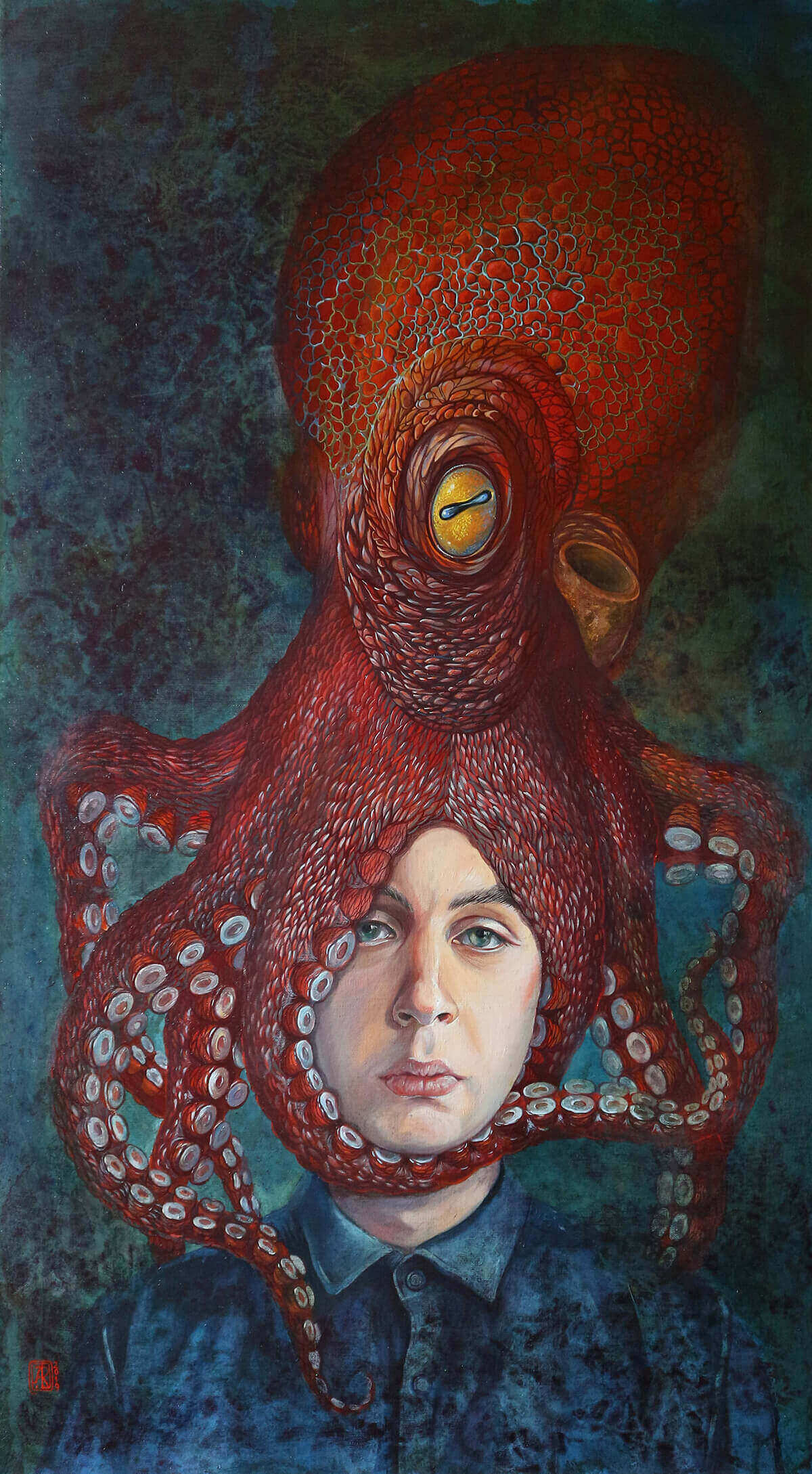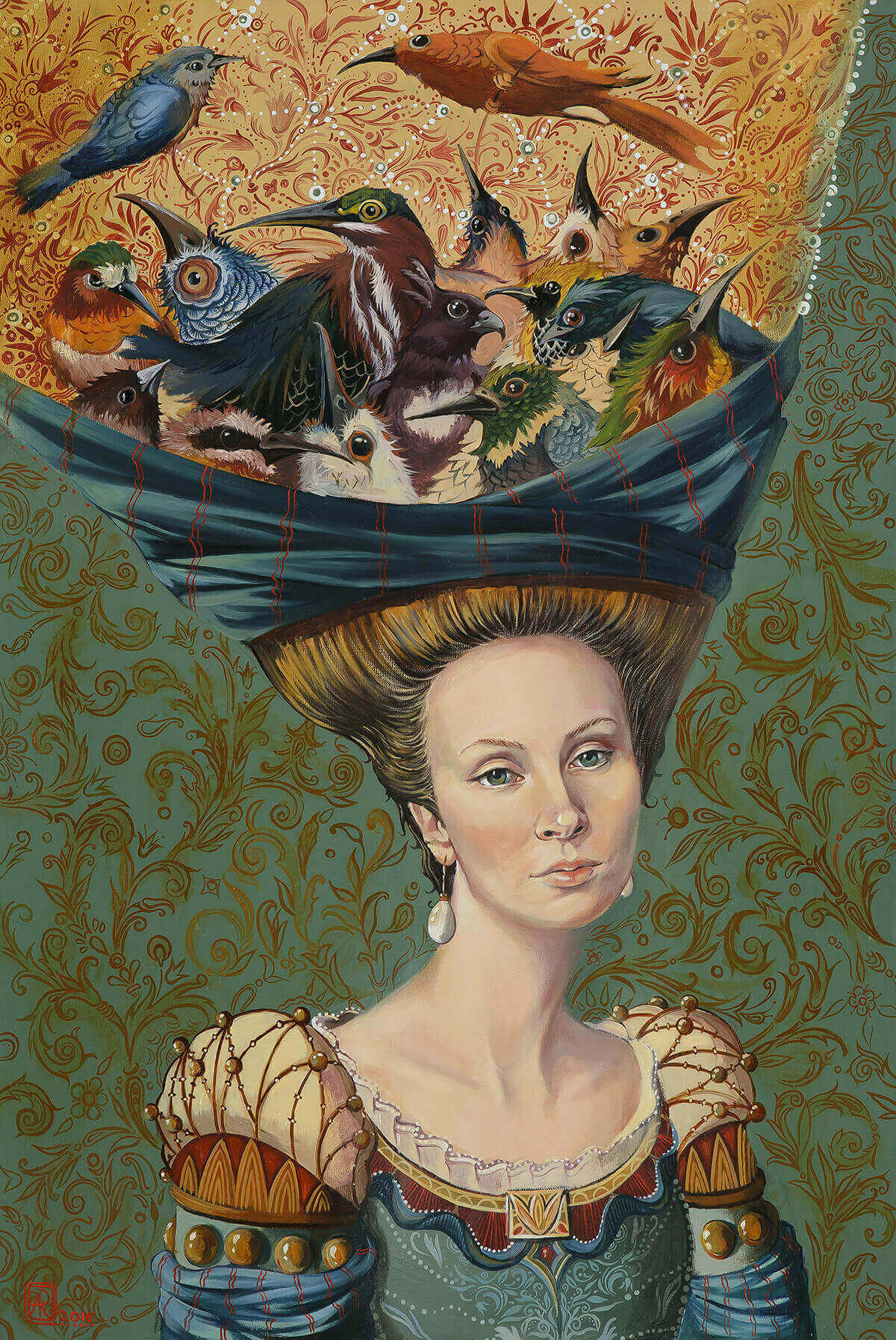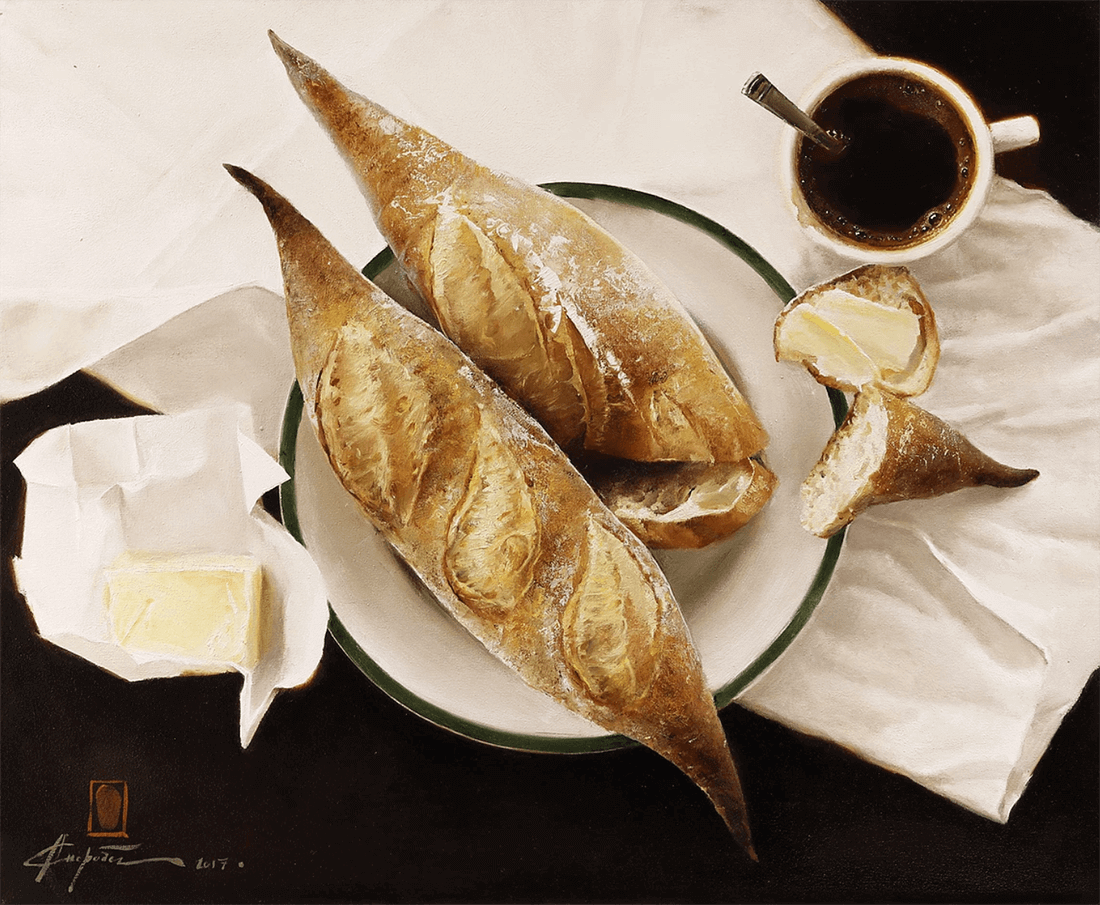Anton Rodionov has radically transformed his creative path
Interview | PAINTING | 16.06.2021
Anton Rodionov has radically transformed his creative path
Interview | PAINTING | 14.06.2021
First, Anton restored icons at the National Art Museum, then moved into the field of IT, and now he works in his own art studio. Chrysalis Mag talked to Anton and found out why it is worth changing the world of classical art for the alternative one and vice versa, how difficult it can be, and why it is important for an artist to follow his dream.

'City of Birds' / oil on canvas / 150 x 120 cm / Minsk, 2020
SHARE:
– Hi, Anton! How did you decide to connect your life with art?
– I've been creating art for as long as I can remember. As a child, I liked to draw tanks and cars — just like other boys. And I modeled things well, too. Parents noticed my abilities and signed me up for ceramics. I liked it, and once I even won third place among the Minsk ceramists.
At one point my favorite teacher left Belarus, and I switched to a drawing class. From that moment on, I've been creating paintings. And now it's as important for me as breathing or eating.
– If you liked painting so much, why would you go to study restoration?
– By accident. I wanted to enroll in monumental painting, but the Academy decided to charge for this course. My parents offered to pay my tuition fee, but I would not allow it, so I decided to study at the Department of Monumental and Decorative Art. The year I enrolled, the department introduced a second major — restoration. I picked it.
As a student, I even managed to work with Belrestavratsiya at the Nesvizh Castle and the Transfiguration Church in Polotsk. We helped qualified restoration artists and learned a lot from them. After the Art Academy, I worked at the National Art Museum for three years restoring icons.

'Heavy Thoughts. Self Portrait' / oil on canvas / 102 x 57 cm / Minsk, 2019
– Can you tell us a little about the restoration process?
– The main thing in restoration is to preserve and conserve the image, and avoid damaging it while restoring.
If the paint layer is damaged, it should be reinforced with sturgeon glue. If there are losses in the paint layer, the artist restores the ground layer and then adds toning, or reconstructs the lost drawing.
It is important to understand that the reconstruction is performed only on the losses. That is why the toning is made with dashes or points so that other restorers could distinguish the restored part from the original one.
– You preserved cultural heritage and at the same time painted — and still are painting — historical pieces. You seem to have a special attitude to history. Is it true?
– I love history very much. As a teenager, I was interested in ancient Egypt and ancient civilizations — like the Sumerian one, for example. My older friends told me a lot of interesting things from history, all of which I analyzed and memorized.
I feel the same way about the history of Belarus. I especially love the period from the Principality of Polotsk to the Napoleonic Wars.
Although the twentieth century is also interesting and it left a vivid mark. Before the Russian Revolution in 1917, for example, many people understood that an artist's work was difficult and that a piece of art had value and an artist should be paid accordingly. In Soviet times, art became widely available, various art clubs emerged en masse, and aside from the obvious benefits, it seemed to devalue art. In Murzilka magazine children had to find out what the artist drew wrong, and laugh at it. Many people still don't understand why art costs so much.

'Bird Songs' / oil on canvas / 130 x 75.5 cm / Minsk, 2019
– What motivated you to move to IT? After all, the High Tech Park is more about creating than preserving or conserving.
– After graduation, I was assigned to work at the National Art Museum [In Belarus, students that received free education have to work at a state job for several years]. I didn't see any prospects there, it all felt like a concrete cover over my head. In the best case scenario, by the age of 40, I would have become a second grade restorer. But I already had a family and a child to feed, so I found a job in IT.
– So you managed to experience two opposite worlds: the world of classical art and the world of contemporary alternative art. Which one was more comfortable, more interesting to you?
– At the IT company, I drew characters: I'd get a sketch of the future character, create a drawing, send it for revision and finalize it. This is a great job for practical and pragmatic people. But for me it's hard to work within this system. I want to work for myself, I want to live and create the way I like it.
All our lives, we depend upon someone else: first, we are guided by our parents, then by our teachers, professors, and supervisors. I wanted to break this vicious circle and now I’m working in my own creative studio.
As time has passed, I can say that self-employment doesn’t usually mean financial stability for an artist. Different things happen. But mentally I feel much more comfortable.

'Birds Are With People ' Series / oil on canvas / 30 cm, tondo / Minsk, 2020
– And speaking of the technical side of the matter: do you prefer a brush or a stylus?
– Tablet is a wonderful thing. I'm sure combining it with brushwork is very useful. The same with the Renaissance artists, who were also engineers and poets, and their art only benefited from it.
By the way, when I changed my field of work to IT, I learned to work on a tablet pretty quickly. It seems that if you know how to paint with a brush, you won't have a problem with a stylus either.

'Spring Dreams' / oil on canvas / 90 x 60 cm / 2016
– Let's also talk about the spiritual side of your art. Tell me, how did you meet Katerina [artist's wife]? When did you first painted her portrait?
– It was when we just met. I was the Academy student and even showcased the painting at the end-of-term display. After studying, I began to paint her more and more, my creativity unfolded in a new way. I love my wife, she is beautiful, so I especially like to paint her portraits.

'Spring in Heart' / oil on canvas / 90 x 90 cm / Minsk, 2020
– What other emotions, besides love, fill you with strength and inspire you to create? Which ones make you feel disempowered?
– An artist can create in different ways, sometimes even in spite of negative emotions. It is good if you can channel your anger into art because creation is always better than destruction. At such moments, creativity allows you to feel free from what is happening.
And what stops you is despair. A state where you just want to get away from everything, lie down in the grass and smoke, looking up at the sky.
– How do you co-exist with your 'inner critic', how do you negotiate with him?
– I don't talk to him. I'm working, just working.
An artist has to work all the time, sometimes he has to see his studio more often than his family. When you work on commission, you have to bring something of your own, do it wholeheartedly, and then everything will work out.
We have a lot of good artists in Belarus, so one needs to try to stand out to occupy their niche in this area. I believe it is possible, even with all this competition.

'Dead Bird' / oil on canvas / 120 x 100 cm / Minsk, 15.08.2020
– Finally, could you give some advice to artists who are at the start of their professional career?
– Listen to your inner voice and don't be afraid to follow your dream. I believe that one should only do what one truly enjoys. If you like graphics, make graphic works, if you like painting, create paintings, and so on. Don't be afraid. Work hard. Don't wait for the muse with a laurel wreath, but try to evolve and live your dream every day.

Anton Rodionov is a Belarusian painter who lives and works in Minsk.
He used to restore paintings for the National Art Museum of Belarus, then worked as an artist-designer at the Belarusian Hi-Tech Park. Presently, he works in his own Anton Rodionov’s Creative Studio.
Since 2017 — member of the Union of Artists of Belarus;
Member of the Neon Head creative association;
Participant of republican exhibitions.
Education:
Minsk State Gymnasium College of Arts;
Belarusian State Academy of Arts, Department of Monumental and Decorative Art (restoration).
All materials are taken from the personal sources of the artist.
Reprinting of material is allowed only with the permission of the publisher.
If you found a mistake or would like to offer an addition to the published materials, please inform us.
SHARE:
Related Materials



